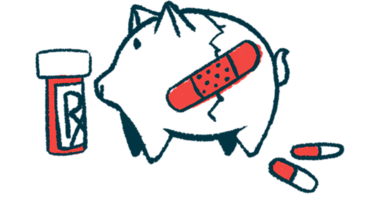Certain barriers to healthcare seen to worsen gMG economic burden
Financial, insurance problems reported by patients in new US survey

People living with generalized myasthenia gravis (gMG) in the U.S. who experience certain barriers to healthcare reported major economic concerns in a new patient survey.
These patients highlighted issues related to managing funds for emergency care, loss of income, and other non-medical expenses as contributing to a greater economic burden, the study showed.
Health barriers — also known as social determinants of health (SDOH) challenges — that were particularly associated with economic stress included the use of public insurance programs such as Medicaid and Medicare, living in non-urban areas, and lack of employment.
“Increasing access to relevant, personalized, and holistic resources, including care management, should be prioritized to improve disease management and outcomes for individuals living with gMG,” the researchers wrote.
The study, “The economic burden of individuals living with generalized myasthenia gravis and facing social determinants of health challenges,” was published in the journal Frontiers in Public Health. It was funded by Argenx US, the company that markets the gMG-approved therapies Vyvgart (efgartigimod alfa) and Vyvgart Hytrulo (efgartigimod alfa and hyaluronidase-qvfc). Argenx was involved in the study from its design to manuscript reviews.
Lower socioeconomic, educational status ID’d as key barriers to healthcare
Living with a chronic disease like gMG comes with a high economic burden for patients and their caregivers and families. This burden arises from direct medical costs — such as medications and doctor’s office visits — as well as direct non-medical expenses like transportation and time off work.
Over time, other indirect costs also can contribute. For example, as patients become more limited in their ability to engage in certain activities, a loss or reduction in employment may occur for both patients and caregivers, leading to income loss.
Non-medical factors that influence health outcomes, called SDOH, may contribute to or worsen this economic burden for gMG patients. SDOH refers to the conditions in which people are born, grow, work, live, and age. This can include factors such as socioeconomic status, educational status, and healthcare or employment access.
SDOH barriers are known to aggravate economic difficulties across a number of different chronic diseases. However, less is known about their influence in the rare disease gMG.
“Although our understanding of the economic burden of individuals living with gMG both globally and in the US is drastically improving, evidence based on traditional research methods systematically excluded the voices of key subgroups that may be facing disproportionate economic challenges and unique unmet needs,” the researchers wrote.
To learn more, researchers turned to interviews and a survey.
First, the team sought perspectives from people with gMG, ages 18-75, living in the U.S. and experiencing various SDOH barriers. During a first interview stage, 11 gMG patients, two caregivers, and two patient advocacy group representatives each completed a 45-minute phone interview with investigators.
These interviews found that the economic burden of gMG was particularly high for patients who were using public insurance programs, living in non-urban areas, and unemployed.
Surveyed individuals indicated that Medicaid did not always cover medical expenses, requiring out-of-pocket payments, and in some cases, government assistance was difficult to obtain. Non-medical expenses, particularly the cost of transportation for those living in non-urban areas, also was an area of economic stress.
After these interviews, the researchers used the information gained to develop a web-based survey consisting of multiple-choice questions related to living with gMG and its economic burden. A total of 38 gMG patients with SDOH challenges were asked to complete the survey.
Most of the participants were enrolled in public insurance programs and were not employed.
Managing funds for emergency care is most common concern among patients
From the survey, researchers identified five economic issues considered major concerns by at least half of the respondents, the most common of which was managing funds for emergency care.
Overall, 95% of respondents considered this a concern to some degree, and 66% considered it a major concern.
Loss of income was considered a major concern by 61% of participants, and 58% counted non-medical expenses as a major issue. The costs of medications and treatments — cited by 55% — and managing finances/budgeting (50%) also were considered major concerns for more than half of participants.
Other issues noted as major concerns by a minority of participants included transportation costs, home modifications, professional caregiving, and childcare.
Our results demonstrated a high degree of concern for both direct (medical and non-medical) and indirect costs among individuals living with gMG and [social determinants of health] SDOH barriers.
The prevalence of certain economic concerns varied by SDOH barrier.
For instance, patients using Medicaid — a public health insurance program for low income individuals — living in non-urban environments, and who were unemployed or retired, more commonly found non-medical expenses to be a major concern relative to other groups. Transportation and applying for government assistance also tended to be concerns for these groups.
People using Medicare, a public insurance program for people older than 65, those who were unemployed, and individuals living in suburban environments more commonly were concerned about the costs of professional caregiving.
“Our results demonstrated a high degree of concern for both direct (medical and non-medical) and indirect costs among individuals living with gMG and SDOH barriers,” the researchers wrote.
Helping to address SDOH barriers could help alleviate the economic burden patients face, according to the investigators.
Still, “the larger challenge appears to be finding adequate and relevant assistance to address them, as clinicians have limited time and resources to directly support diagnosed individuals beyond the clinical realm,” the team wrote.
The researchers noted the economic burden of gMG was greater for adults facing SDOH issues, but called for improved healthcare for all patients with the disorder.
“While further research is required to confirm and extend our findings, holistic improvements in institution- and policy-level healthcare structures and processes may be crucial to improve support, access, and outcomes for not only individuals living with gMG impacted by SDOH challenges but also the larger gMG community,” the team concluded.









Leave a comment
Fill in the required fields to post. Your email address will not be published.